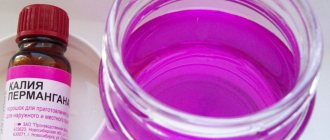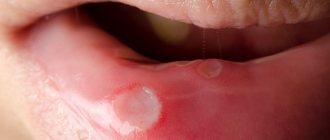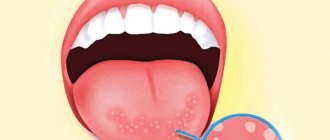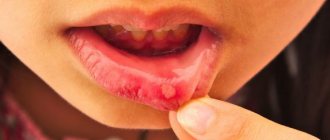What is stomatitis?
Stomatitis is an inflammation of the oral mucosa. According to statistics, about 20% of the population of our planet faces it. In adults and children, it can take the form of an independent disease or act as a symptom indicating pathologies of the body. In both cases, treatment is carried out comprehensively and under the supervision of a doctor.
What does the disease look like?
Stomatitis is not difficult to recognize. The initial stage of the disease is characterized by the appearance of mild swelling of the oral mucosa. It becomes redder, drier and shiny. A plaque may appear on its surface, and at the site of future lesions the patient feels an unpleasant itching or burning sensation.
As the disease develops, small ulcers and wounds appear on the mucous membrane - painful oval or round lesions. Their location may be the inside of the lips, cheeks, palate, tonsils, or mucous membrane under the tongue. Their appearance can be seen in the photo at the end of our article.
Herpetic stomatitis
The form of stomatitis discussed in this section of the article reveals itself with the following symptoms: general weakness, mild headaches, hyperthermia, slight enlargement and slight soreness of the lymph nodes under the lower jaw. The mucous membrane of the mouth becomes bright scarlet, swells, and groups of tiny bubbles with clear liquid appear on its surface. Most often, clusters of such bubbles are observed in the lips, cheeks, tongue and palate.
As the disease process develops, the blisters begin to burst and turn into multiple ulcers covered with a whitish coating. The gums at the edges turn red, rashes with herpetic stomatitis can appear on the lips and skin of the lips, similar symptoms are observed with gingivitis, therefore, without being a specialist, you can confuse these two diseases, which also sometimes accompany each other. For this reason, it is not recommended to engage in self-diagnosis, and at the first suspicion of herpetic stomatitis, consult a dentist. You can always get professional advice on the treatment of stomatitis at our dentistry in Moscow - Vanstom. We are located in the center of Moscow, near the Baumanskaya metro station, and you can make an appointment with the clinic’s doctors either by phone or through the feedback service that works for you on our website.
Causes of stomatitis
The mechanism of stomatitis is not yet fully understood. But scientists are inclined to believe that the root cause of its development is the reaction of the human immune system to various irritants. At some point, the immune system ceases to recognize the potential threat of internal and external factors, which causes its atypical reaction, as a result of which “aggressive behavior” of lymphocytes is observed. The attack of lymphocytes against irritant molecules leads to lesions of the oral mucosa.
A variety of factors can provoke an atypical reaction of the immune system. The most likely of them are the following irritants:
- Pathogenic microorganisms that live in the mouth.
- Improper oral hygiene.
- Various damage to the mucous membrane, for example, burns from eating too hot food or mechanical injuries from seeds, nuts, crackers and other hard foods.
- General dehydration due to high fever, blood loss, vomiting, diarrhea, or thirst.
- Poor quality treatment of teeth and gums.
- An allergic reaction to dental structures in the mouth - braces, implants, crowns, bridges, etc.
- Long-term use of medications.
- A diet depleted of beneficial vitamins and elements.
- Smoking.
- Malignant formations of the oral cavity, respiratory organs or undergoing a course of chemotherapy.
- Hormonal imbalances in the body, for example in pregnant women or children during puberty.
- The presence of chronic diseases or allergies.
- Severe stress.
Interesting to know! Frequent stomatitis in adults can be caused by the use of toothpaste containing sodium lauryl sulfate, a substance added to oral care products to form a thick foam. According to recent studies, it dehydrates the oral mucosa and makes it vulnerable to various types of irritants. Patient observation data confirms the fact that avoiding the use of sodium lauryl sulfate paste can reduce the risk of developing stomatitis in adults by 81%.
Tips for choosing toothpaste and brushing your teeth
Frequent use of toothpaste with sodium lauryl sulfate (SLS) can lead to dehydration of the mucous membranes, so when buying a toothpaste, pay attention to its composition. You should also be careful when using whitening pastes, because... they contain mechanical abrasives or chemically active substances that can damage tooth enamel. This will lead to increased proliferation of bacteria in the oral cavity, and consequently, the risk of stomatitis. When brushing, hold the brush at an angle of 45° to the surface of the teeth, make circular movements, lightly pressing on the brush. To improve the result, you can use additional means: threads, floss, interdental brushes, irrigators and rinses.
Symptoms of the disease
Stomatitis can occur at any age. In the early stages, its course is accompanied by swelling, redness and dryness of the oral mucosa. The main sign of the disease is the presence of one or multiple ulcers and their appearance.
- Oval or round ulcer shape.
- Small sizes.
- Smooth edges.
- The presence of a thin grayish or white film in the central part of the ulcer.
- The ulcer is surrounded by a slightly reddish halo.
- The mucosal tissue around the lesion has a normal, healthy appearance.
The slight itching or burning sensation that the patient experienced at the beginning of the disease is replaced by pain. The ulcers hurt when eating, talking and smiling broadly. Any touch to them causes pain, which complicates hygiene measures and leads to bad breath.
On average, the disease lasts from 4 to 14 days. Its clinical picture depends on the individual characteristics of the organism, the form and type of the disease. During this period, in addition to the main signs of pathology, other symptoms of the disease may be observed.
- Increase in temperature - during the first days, until characteristic ulcers appear (in severe forms of stomatitis, the elevated temperature persists throughout the entire illness).
- General malaise and fatigue.
- Chills.
- Headache.
- Lack of appetite (especially in children).
- Enlarged lymph nodes (in rare cases).
Important to remember! Severe inflammation, toothache or high temperature for a long time indicate a severe form of stomatitis or the development of its complications. In this case, immediate medical attention is required, and if necessary, hospitalization of the patient is possible.
Symptoms
A number of symptoms are characteristic of candidal stomatitis:
- The appearance of a white or yellowish coating on the tongue, cheeks or palate. When trying to eliminate it, bleeding wounds may appear on the mucous membrane.
- Constant metallic taste.
- Feeling of heartburn on the tongue.
- Painful sensations from touching plaque.
- Later, as plaque spreads, difficulty swallowing occurs.
- Deterioration of tongue sensitivity and poor taste perception.
Can stomatitis go away on its own?
As a rule, mild forms of the disease caused by trauma to the mucous membrane, poor oral hygiene or an allergic reaction of the body can go away on their own. Severe stomatitis caused by infection requires qualified treatment. In both cases, it is better not to wait and not to self-medicate. Because the disease not only causes pain and discomfort, but can also lead to generalization of infection and serious complications.
Consequences and complications of the disease
Possible complications arise when the patient ignores treatment for stomatitis. As a result, mild and severe forms of the disease become chronic. The neglected process turns into an ulcerative-necrotic and then gangrenous form of the disease, as a result of which not only the mucous membrane is damaged, but also the soft tissues of the mouth and jaw bones.
Other serious consequences of untreated stomatitis include the following complications.
- Bleeding gums.
- Scarring of the oral mucosa, disruption of its elasticity and mobility.
- Attachment of a secondary infection.
- Tooth loss.
- Voice changes – hoarseness, hoarseness.
Important to remember! A small ulcer on the oral mucosa is a potential threat to the entire body. Infection from it can spread to other organs and systems, which will disrupt the functions of the heart, liver, kidneys, gastrointestinal tract and respiratory organs.
Diagnostics
Collecting anamnesis (information about living conditions, previous diseases) is the most important stage of diagnosis. It makes it possible, even during examination, to suggest the genesis of stomatitis. In addition, the following are most often prescribed:
- general blood analysis;
- PCR diagnostics (molecular diagnostic method based on the study of RNA and DNA);
- Culture for microflora (taking a smear from the surface of the ulcers);
- feces for dysbacteriosis.
In case of frequent relapses, it is advisable to undergo a full examination, because this may indicate the presence of serious disturbances in the functioning of the gastrointestinal tract, endocrine system, ENT organs, etc.
Folk remedies
For treatment, you can use traditional medicine. The following juices, decoctions, oils and infusions have proven themselves well.
You can gently lubricate the affected areas of the mucous membrane with juices and oils. Solutions and decoctions of herbs are used for regular rinsing of the mouth.
Important! Before using traditional medicine, you should consult a doctor. Only a specialist can determine the advisability of their use without harm to health. The use of folk remedies does not cancel the main therapy, but only complements its effect.
Medicines for stomatitis in children: how to treat?
Selecting the right children's medicine for the medical treatment of stomatitis is a rather delicate process. After all, at different ages, children need to be treated differently: those drugs that are suitable for a one-month-old baby may not affect the course of the inflammatory process at all in a two-year-old child.
The same applies to the question of how long it is necessary to treat such a pathology. In infants, a one-year-old baby and a 2-year-old child, recovery times will also differ, even when using the same remedy. In any case, you should not expect quick treatment, since it takes several days to several weeks to relieve inflammatory reactions and heal damaged tissues.
Drug treatment
Drug treatment is aimed at relieving symptoms of stomatitis such as pain and inflammation, as well as accelerating the healing process of damaged tissue.
Painkillers
Since young children have a fairly low pain threshold, pain relief is the primary goal in the treatment of acute stomatitis. For this purpose, both system-wide drugs for oral administration and local agents in the form of gels are used.
Painkillers for oral administration:
- Ibuprofen is a strong drug that has a pronounced analgesic, anti-inflammatory and antipyretic effect. Its dosage is prescribed at the rate of up to 10 mg per kg of the child’s weight three times a day for no more than 5 days in a row. Can be used no earlier than 3 months of age.
- Paracetamol also relieves pain and fights high fever. For children under three years of age, it is preferable to use rectal suppositories or syrup, while older children can use tablets. The dosage is calculated based on the child’s weight (15 mg per kilogram). It is possible to use the product 3-4 times a day.
Local anesthetics:
- Cholisal is a drug with a good analgesic effect, which additionally has anti-inflammatory and antibacterial effects. Apply the gel to damaged mucous membranes 3-4 times a day before or after meals, as well as before bed. It is not advisable to use before 9 months of age.
- Kamistad - a combination of lidocaine with chamomile infusion gives a good analgesic and anti-inflammatory effect. The gel should be used 3-4 times a day, rubbing it into the area of inflammation.
- Kalgel is a combined drug in the form of a gel with antimicrobial and analgesic effects. Well relieves pain from stomatitis, gingivitis and other inflammatory diseases in the oral cavity. Use no more than 6 times a day.
Antiseptic and anti-inflammatory agents
Drugs with antiseptic properties suppress the activity of pathogenic microorganisms and have a good anti-inflammatory effect. They can be used both for rinsing the entire oral cavity and for treating individual areas of damaged oral mucosa. They are successfully used to treat stomatitis at home.
Sprays for the treatment of stomatitis:
- Hexoral is a spray with pronounced activity against pathogenic microflora. Used after meals and remains effective for up to 12 hours. It is used twice a day by briefly spraying the solution in the mouth.
- Inhalipt is a combination drug that combines a soluble form of streptocide in combination with essential oils. It has anti-inflammatory, antiseptic and minor analgesic effects. Oral irrigation is carried out 3-4 times a day until the symptoms of stomatitis disappear.
- Chlorophyllipt is a spray with an antiseptic effect. Suppresses pathogenic microflora, promotes rapid healing of ulcers. Used to irrigate the oral cavity 2-3 times a day until recovery.
Iodine-based preparations:
- Lugol is an iodine-based drug with a pronounced t effect. Used as a spray for irrigating the oral cavity and in a solution for treating damaged areas of the mucous membranes. Treatment of the affected areas is carried out 2-3 times a day using a cotton swab or by spraying a spray.
- Iodinol is another iodine-based medicine. It has low toxicity and is destructive to most microorganisms and fungi. It is not used for stomatitis in children under one year of age, as there is a high risk of swallowing the drug. For children aged 1.5 years and older, it can be used as a mouth rinse (5 ml of solution is diluted in 50 ml of warm water). The procedure is carried out 4-5 times a day, no more than 5 days in a row.
Mouth rinse solutions:
- Stomatidin is a powerful antiseptic with a pronounced anti-inflammatory effect. Used for rinsing the mouth or treating damaged surfaces with an undiluted solution. The procedure is carried out 2-4 times a day, with an interval of at least 4 hours between them. The course of treatment usually lasts 7 days.
- Miramistin is a drug with a broad spectrum of action against pathogenic flora. It eliminates signs of inflammation well. It is used in the form of a solution, which is used to treat areas of stomatitis, or in the form of aerosols, which are applied to the entire oral cavity. The frequency of the procedure is 2-3 times, the duration of the course of treatment is 7 days.
- Chlorhexidine is a solution with an antiseptic effect. Suppresses the growth of pathogenic bacteria and helps the body fight inflammation. Children over 7 months of age can treat the oral cavity with a solution diluted with boiled water (the ratio of water to the drug is 1:1), children over 5 years old can rinse their mouth with a regular solution. Repeat the treatment procedure 2-4 times a day until the symptoms of stomatitis disappear.
- Furacilin is a fairly broad-spectrum antiseptic. Does not cause irritation to mucous membranes. Available in the form of a ready-made solution or tablets. To prepare the solution at home, you need to dissolve 1 tablet of furatsilin in 500 ml of warm boiled water. You need to rinse your mouth with this solution 3-4 times a day until complete recovery. For small children under 2 years of age, the drug can be applied with a gauze swab directly to the inflamed area.
- Hydrogen peroxide as an antiseptic can be used to treat stomatitis in older children. The use of such a product must be careful, since it is toxic and can cause serious burns to the mucous membranes. To prepare a rinse solution, dissolve 1 teaspoon of peroxide in 100 ml of water. Carry out the procedure three times a day after meals. The course of such treatment is 5-7 days.
- Stomatofit is a plant-based drug that has bactericidal, anti-inflammatory and tanning effects. To rinse the mouth, 10 ml of solution is mixed with a quarter glass of water. Treatment is carried out 3-4 times a day until complete recovery.
Anti-inflammatory and antiseptic gels:
- Metrogyl denta is a combined remedy for the treatment of inflammatory diseases of the oral cavity. The gel is applied to areas of the mucous membrane affected by stomatitis three times a day. The course of treatment is approximately 7 days.
Vitamin and regenerating products
Vitamins and wound-healing agents in the treatment of stomatitis are used after acute symptoms have subsided. Their main task is to speed up the regeneration processes in damaged tissues, maximally restore their metabolism and adequate blood supply. Such drugs are most often used topically in the form of oils, gels, and ointments.
The most commonly prescribed drugs are:
- Aekol is an oil solution of vitamins A, E, K and provitamin A. The product is applied directly to the affected area on a gauze bandage once every 48 hours. The treatment course continues until the mucous membrane is completely restored.
- Vinilin - has an anti-inflammatory effect and at the same time stimulates the healing of damage to the mucous membrane. Apply the drug using a cotton swab directly to the affected area after each meal and before bedtime until the clinical manifestations completely disappear. According to the instructions, it can be used after one year of age.
- Solcoseryl is a paste that stimulates the processes of epithelization of damaged tissues, promoting the rapid healing of ulcerative defects in stomatitis. For children, it is necessary to apply the drug 3-4 times a day after thoroughly rinsing the mouth with clean boiled water and drying the inflamed areas with sterile cotton pads.
- Sea buckthorn oil is a natural remedy that has a regenerating effect. After the acute symptoms have subsided, apply with a sterile cotton swab to the inflamed areas twice a day.
How many days does treatment last?
Correct, competent treatment of stomatitis significantly speeds up the healing process. Depending on the type of disease, it lasts for 3 to 7 days. If after 1 week of treatment the signs of the disease have not disappeared or worsening is observed, then the patient most likely has complications. The following factors may be the probable reasons for its development.
- The patient self-medicated or did not follow the doctor's instructions.
- Decreased immunity.
- The presence of chronic diseases of the body.
- Regular injury or infection of the oral mucosa.
- Undiagnosed allergy.
- Having bad habits - smoking, tearing, etc.
- Depression or frequent stress.
- Improper oral hygiene.
- Uncontrolled use of medications.
- The use of oral hygiene products containing sodium lauryl sulfate.
Returning to the question - can stomatitis go away on its own - it should be noted that a seemingly harmless disease can turn into serious problems for the patient. Therefore, you should remember three “don’ts” - don’t
engage in self-medication,
do not
put off visiting a specialist and
do not
ignore the recommendations of your doctor.
How to understand that stomatitis has passed?
Very simple! A complete cure is indicated by the absence of lesions in the oral mucosa. There are no small ulcers, wounds or plaque on the cheek, palate, lip, tongue or tonsil area. The mucous membrane looks healthy, is well moisturized, does not cause pain and does not create discomfort during eating, talking, smiling and performing hygiene procedures.
Homeopathic treatment
Many parents prefer to treat their children with homeopathy. However, such treatment should only be auxiliary and complement traditional methods.
In pediatric practice, the following drugs can be used:
- Borax,
- Mercuriussublimatuscorrosives,
- Natrum muriaticum,
- Arsenicum.
The group of homeopathic medicines also includes the combination remedy Malavit, which combines homeopathic components, natural herbal extracts and water from artesian springs. For rinsing with stomatitis, a solution is prepared from 5 drops of the drug and 100 ml of water (children under 5 years old need only one drop per year of life). The procedure is carried out 3-5 times a day after meals.
Types of stomatitis in adults
The clinical picture of the disease indicates that stomatitis can be mild or severe, have an acute or chronic course. To facilitate the diagnosis and treatment process, experts have developed the following classification of the disease.
- Allergy is usually a chronic disease that occurs as a result of an allergic reaction of the body to an irritant. In addition to the characteristic ulcers, it may be accompanied by the appearance of white spots, blisters and small hemorrhages on the mucous membrane.
- Herpetic or herpes - the disease occurs due to the entry of the causative agent of the herpes virus into the human body. Stomatitis of this type is characterized by an acute course. Bubbles appear on the surface of the mucous membrane, which open to form erosions and crusts.
- Traumatic (bacterial) – a consequence of mechanical trauma to the oral mucosa and infection entering the wound. As a rule, the disease is mild, with symptoms characteristic of stomatitis.
- Catarrhal and catarrhal-hemorrhagic stomatitis is a mild form of stomatitis, the causes of which are poor oral hygiene, the development of candidiasis, decreased immunity or gastrointestinal pathologies. The disease is accompanied by a typical clinical picture for the disease.
- Candidal (fungal) stomatitis is an acute form of the disease, the so-called thrush, caused by the activity of bacteria of the genus Candida. It is most common in young children, the elderly, and patients who overuse antibiotics. Accompanied by the appearance of a white coating on the mucous membrane, a burning sensation and an unpleasant taste in the mouth.
- Ulcerative is a severe form of the disease that occurs independently or as a result of a complication of the catarrhal course of stomatitis. It occurs acutely, with increased body temperature and enlarged lymph nodes. The resulting ulcers are very painful and can unite and form extensive lesions of the mucous membrane.
- Aphthous stomatitis is a severe form of the disease, occurring acutely or chronically. Accompanied by the appearance of single or multiple gray-white ulcers. The ulcers are surrounded by a red halo and are very painful.
It is important to know! By analyzing the condition of the oral mucosa, the nature of the ulcers and the patient’s complaints, specialists accurately determine the type of stomatitis and make an accurate diagnosis. Thanks to this, treatment of the disease occurs quickly and without complications.
Features of the treatment of some forms of stomatitis
In addition to the use of antiseptic, analgesic, anti-inflammatory and wound-healing agents, various forms of stomatitis may require the use of other drugs that will act directly on the cause of the disease.
Bacterial stomatitis
For bacterial stomatitis, in addition to general treatment measures, the use of antibacterial agents is most often indicated. Which antibiotics should be taken is decided only by the attending doctor, who prescribes the drug depending on the clinical manifestations, the age of the small patient and examination data.
Candidal or fungal stomatitis
For fungi of the genus Candida, an alkaline environment is destructive, therefore, when treating candidal stomatitis, maximum alkalization of the oral cavity is achieved. In young children, for this purpose, you can use a solution of baking soda (1 teaspoon per small glass of water), which I treat the mucous membranes with twice a day.
In severe cases, the use of antifungal drugs is indicated:
- Candida for the oral cavity is a solution based on clotrimazole. Apply to inflamed areas 2-3 times a day. The course of treatment is 7-10 days, which cannot be interrupted due to the high risk of relapse.
- Nystatin is a drug with a pronounced antifungal effect. It is used in the form of a solution (prepared by dissolving tablets in warm boiled water) or cream. Apply to the affected areas 2 times a day.
- Fluconazole (Fucis) is a tablet form of an antifungal drug that can be used to treat severe forms of candidal stomatitis. In children, the dose is up to 12 mg per kg of body weight per day. The duration of treatment is determined by the severity of the condition.
Infectious (herpetic) stomatitis
Since the cause of the development of herpetic stomatitis is the herpes virus, if it occurs, the child is advised to use antiviral drugs.
- Oxolinic ointment - oxolinum shows high effectiveness against the herpes simplex virus. For herpetic stomatitis, it is necessary to apply the ointment 1-2 times a day to the area of the rash.
- Acyclovir is an antiviral agent. Prescribed to children with severe forms of herpetic stomatitis. The pediatric dosage is 100 mg 5 times a day for 5 days. Intravenous use is possible for infants. Applying 5% ointment or cream to the mucous membranes of a child is undesirable, as this may cause an increase in the inflammatory reaction.
- Viferon is a drug that has antiviral and immunostimulating effects. In pediatric practice, it is used in the form of rectal suppositories (twice a day), or as an ointment for the treatment of herpetic infections of the skin and mucous membranes (applied 2-3 times a day).
Ulcerative stomatitis
Often ulcerative stomatitis appears against the background of other diseases. Therefore, treatment is carried out specifically for the underlying disease. If the cause is poor oral hygiene, then the first step is to teach proper dental care.
If the causes are pathologies of the gastrointestinal tract, endocrine or immune system, then correction of these disorders is necessary.
Local treatment measures will include adequate pain relief, the use of antiseptics to prevent additional infection, and wound-healing medications.
Allergic stomatitis
Treatment of allergic stomatitis comes down to identifying a possible allergen, eliminating its influence and using antihistamines:
- Parlazin is a long-acting antiallergic drop. For children from three months of age to one year, the dosage is 3 potassium 1-2 times a day, over a year - 5 drops.
- Suprastin is an antihistamine that can be used in pediatric practice. Children under one year old can use 10 mg of the drug (a quarter of a tablet). After a year, the dosage is increased to 20 mg (half a tablet) 2 times a day.
At the same time, the child must be provided with hypoallergenic food and avoid contact with household chemicals and pets.
Traumatic stomatitis
In case of traumatic stomatitis, it is necessary to limit the oral cavity as much as possible from the effects of irritating food and food. It is imperative to carry out complete pain relief and use anti-inflammatory and wound-healing agents. If necessary, a course of antibiotics is prescribed.
Which doctor should I contact for stomatitis?
If you notice the first signs of damage to the oral mucosa, you should immediately consult a dentist. After differential diagnosis of the disease and an accurate diagnosis, it is possible to observe it with a general practitioner or other specialized specialist, for example, an allergist.
Do not ignore preventive visits to the dentist.
It is enough to visit a specialist 1 – 2 times a year, which will allow you to promptly identify any dental problem at an early stage of development. This means that its elimination will be quick, easy and without complications.
By clicking the “request a call” button you agree to the personal data processing policy.
Table of children's medications against stomatitis by age
| Drug/Age | 1 month | 3 months | 4 months | 5 months | 7 months | 1 year | 2 years | 3 years | 5 years | 6 years | 10 years |
| Paracetamol | + | + | + | + | + | + | + | + | + | + | + |
| Soda | + | + | + | + | + | + | + | + | + | + | + |
| Candide | + | + | + | + | + | + | + | + | + | + | + |
| Viferon | + | + | + | + | + | + | + | + | + | + | + |
| Suprastin | + | + | + | + | + | + | + | + | + | + | + |
| Ibuprofen | — | + | + | + | + | + | + | + | + | + | + |
| Holisal | — | — | + | + | + | + | + | + | + | + | + |
| Kamistad | — | — | + | + | + | + | + | + | + | + | + |
| Parlazin | — | — | + | + | + | + | + | + | + | + | + |
| Kalgel | — | — | — | + | + | + | + | + | + | + | + |
| Chlorhexidine | — | — | — | — | + | + | + | + | + | + | + |
| Furacilin | — | — | — | — | + | + | + | + | + | + | + |
| Iodinol | — | — | — | — | — | + | + | + | + | + | + |
| Vinylin | — | — | — | — | — | + | + | + | + | + | + |
| Malavit | — | — | — | — | — | + | + | + | + | + | + |
| Fduconazole (Futsis) | — | — | — | — | — | + | + | + | + | + | + |
| Ingalipt | — | — | — | — | — | — | + | + | + | + | + |
| Honey | — | — | — | — | — | — | + | + | + | + | + |
| Propolis | — | — | — | — | — | — | + | + | + | + | + |
| Nystatin | — | — | — | — | — | — | + | + | + | + | + |
| Oxolinic ointment | — | — | — | — | — | — | + | + | + | + | + |
| Hexoral | — | — | — | — | — | — | — | + | + | + | + |
| Miramistin | — | — | — | — | — | — | — | + | + | + | + |
| Lugol | — | — | — | — | — | — | — | — | + | + | + |
| Stomatidin | — | — | — | — | — | — | — | — | + | + | + |
| Stomatophyte | — | — | — | — | — | — | — | — | — | + | + |
| Metrogil Denta | — | — | — | — | — | — | — | — | — | + | + |
| Hydrogen peroxide | — | — | — | — | — | — | — | — | — | — | + |
| Chlorophyllite | — | — | — | — | — | — | — | — | — | — | + |
| Aekol | — | — | — | — | — | — | — | — | — | — | + |
How to distinguish stomatitis from other diseases?
The main sign of stomatitis is the presence of characteristic ulcers, the tissue around which looks healthy. The disease is rarely accompanied by systemic symptoms and, as a rule, recurs from time to time. For a competent specialist, it is not difficult to distinguish stomatitis from other ailments.
For a sore throat
When you have a sore throat, your body temperature always rises. In this case, it is not the ulcers themselves that hurt, but the throat area. Upon visual examination, the tonsils appear swollen, inflamed and red.
For herpes
The problem is that herpetic stomatitis is one of the manifestations of herpes. A viral disease is accompanied by the formation of characteristic blisters that burst and dry out. In the presence of other types of stomatitis, the nature of the ulcers is completely different.
For cancer
Ulcers due to cancer of the oral mucosa do not go away on their own even after treatment. Over time, they increase in size and may bleed and become painful.
From thrush
Candidal stomatitis is thrush caused by the activity of bacteria of the genus Candida. In all other cases, the nature of the disease will be different and can be easily distinguished from thrush by the presence of characteristic ulcers.
For syphilis
When infected with syphilis, a red spot appears on the surface of the mucous membrane. Gradually it thickens, takes the form of a dense nodule and ulcerates - a typical hard chancre is formed, which is completely different from ulcers with stomatitis.
Treatment of bacterial stomatitis
This type of stomatitis is also called prosthetic stomatitis, since it occurs due to unsatisfactory care of the orthopedic structure, when many pathogenic microorganisms accumulate in the area of contact between the prosthesis and soft tissues. After treating foci of inflammation, it is necessary to carry out complete cleaning and antibacterial treatment of the prosthesis or replace it. This type of stomatitis should not be confused with allergic stomatitis, which develops against the background of an allergy to the prosthetic material. In this case, the prosthesis must be changed to a hypoallergenic one.
Treatment methods
- Anti-infective therapy.
- Mouth rinse.
Recommendations during treatment
Treatment of stomatitis should be carried out comprehensively - local therapy, taking medications appropriate to the type of disease, and strengthening the immune system. During the treatment period, you must adhere to the following recommendations.
- Compliance with the diet - you need to exclude from the diet spicy, salty, sour, too sweet, smoked, hot, cold and any dishes that are traumatic to the mucous membranes.
- Maintaining oral hygiene . To maintain it, it is necessary to use antiseptic agents that you regularly rinse your mouth with.
- Taking vitamin-mineral complexes that strengthen the body's protective functions.
If the doctor has diagnosed the presence of candidal stomatitis, then you should not drink milk or consume fermented milk products, which activate the activity of pathogenic fungi.
Any medications should be used only as prescribed by a doctor. Especially antibiotics.
It is important to know! It is not recommended to cauterize emerging ulcers with pure alcohol solutions. The only thing that is allowed is treating the lesions with a weak solution of iodine or potassium permanganate.
Medicinal methods of treating stomatitis
Treatment involves an integrated approach and depends on the type of stomatitis. Includes general treatment (taking tablets orally, injections) and local therapy (rinsing, ozonation of lesions, laser therapy, applications with painkillers). In different cases, the following drugs are prescribed (together or separately):
- anti-inflammatory (Nimesulide, Miramistin, Cholisal);
- antiviral (Acyclovir, Zovirax);
- antiseptic (Eludril solution, chamomile, Furacilin);
- antihistamines (Suprastin, Fenistil);
- painkillers (Hexoral, Lidocaine);
- keratoplasty (olive and sea buckthorn oils, vitamins).
Note! Medicines should be prescribed only by a doctor, after examination and testing. Self-medication is unacceptable! To increase the effectiveness of drug treatment, it is recommended to adhere to a certain diet, excluding spicy, sour and salty foods from the diet. It is advisable to refrain from consuming too hot food and drinks, as well as crackers, cookies and the like (they can cause additional injury).
Prevention
To avoid the occurrence of stomatitis and its relapses, you should adhere to the following recommendations.
- Maintain oral hygiene.
- Avoid using products containing sodium lauryl sulfate.
- Protect the oral mucosa from injury.
- To treat teeth and gums, contact experienced, qualified specialists.
- Balance your diet with healthy foods.
- Strengthen immunity.
- Be attentive to your physical health and psycho-emotional state - if necessary, seek help from specialized specialists.
And do not forget that herpes stomatitis can be transmitted from person to person - follow the rules of hygiene.
Antiviral drugs for stomatitis
In the treatment of herpetic stomatitis, antiviral drugs in the form of tablets can be used. The disease can be cured in just one day using modern remedies in increased dosages. For this purpose, experts recommend using the following medications:
- Famciclovir (analogs - Minaker, Famvir). The drug is taken once. You can drink the entire required dose of 1500 milligrams at once or divide the indicated dose of the medicine into two or three doses within one day. A one-time dose of these drugs will be enough to cure herpetic stomatitis, however, the cost of these drugs in the pharmacy will be quite high;
- Valacyclovir (analogs - Valtrex, Valavir). The course of therapy with these drugs will also be only one day. The medicine is taken twice a day at a dosage of 2000 milligrams (at one time), the interval between doses should be at least twelve hours.
A budget analogue of the funds considered will be the medicine “Acyclovir”. Modern dentists do not recommend it as ineffective and outdated; Acyclovir does not give a positive result against most types of herpes virus.
Photo of stomatitis
Author: Elena Grunina Dentist-therapist, endodontist. Work experience more than 9 years. The information is for reference only. Before treatment, consultation with a doctor is necessary.
Gels for applications and antiseptics for rinsing
This group of medications will include various gels and antiseptics for rinsing. Solutions are not used in the therapeutic process, since they do not have the ability to destroy the herpes virus and block its reproduction process. Experts recommend using the following means:
- Miramistin is a broad-spectrum antiseptic. In the treatment of herpetic stomatitis, it is used for rinsing, which must be done at least four times a day. After using the antiseptic, it would be advisable to apply an immunostimulating ointment to the affected soft tissues of the oral cavity;
- Viferon is a medicine produced in the form of a gel and containing interferons, which are equally active in the process of destroying viruses and restoring immunity. The gel is applied to clean and dry areas of the mouth several times a day. The duration of the therapeutic course is one week.
Immunostimulants are also used in the treatment of herpetic stomatitis. Experts recommend using medications in this group as an adjuvant that can restore the effectiveness of the body’s immune system and prevent relapses of stomatitis in the future. For this purpose, you can use Amiksin, Imudon, and various vitamin and mineral complexes.
To relieve symptoms of herpetic stomatitis such as fever, traditional antipyretic medications are used, but their use is advisable only if the body temperature has exceeded 38 degrees. If herpes is present on the dermis of the face and the outside of the lips, analogues of the antiviral agents listed above, produced in the form of gels, can be used to treat it.
Important: herpetic stomatitis is a contagious disease and therefore a sick person should have separate dishes for the period of treatment of the disease, and close contact with other people should be strictly excluded.
Relapses of chronic herpetic stomatitis can be excluded if you monitor the state of the body's immune system and regularly strengthen it. It will also be useful to pay attention to general body hygiene and limit contact with strangers. You should know that relapses of the disease can be caused by a deficiency of certain substances in the body, so periodic intake of vitamin complexes will be a useful measure.
An excellent preventative measure is daily high-quality oral hygiene, as well as regular visits to the dentist for professional teeth cleaning. The disease can manifest itself in diseases of the gastrointestinal tract, anemia, stress, and therefore measures aimed at strengthening the overall health of the body will help to avoid its occurrence. Chronic aphthous stomatitis
This form differs from other types of stomatitis by its specific feature - the appearance on the mucous membrane of small but very painful ulcers, which dentists call with a special term - “aphthae”. The ulcers are covered with a dense whitish coating and have bright red edges. Ulcers appear anywhere in the oral cavity, and their presence in the mouth causes significant discomfort to a person: unpleasant painful sensations occur when eating and drinking, or talking.
Aphthous stomatitis has its own classification according to the nature and extent of damage to soft tissues and mucous membranes and is diagnosed at a dentist’s appointment - usually an examination of the oral cavity is sufficient, but sometimes a specialist can take a smear for analysis to accurately determine the cause that caused aphthous stomatitis in the patient.
Allergic denture stomatitis
This form of the disease is an allergic reaction to an installed denture or other orthodontic structure. Most often, it is observed when wearing acrylic structures, to which one of the components, the monomer, may be added in incorrect quantities during manufacture. If there is more monomer in the plastic than necessary, in 90% of cases there is a chance of allergic prosthetic stomatitis.
To diagnose the exact form of the disease, you should visit a specialist who will examine the oral cavity, examine the denture, and prescribe saliva tests for the presence of certain enzymes. If the diagnosis shows the allergic nature of the occurrence of stomatitis, then in these circumstances only one treatment option will be possible, which involves replacing the prosthesis with a high-quality design or even with a prosthesis made of a different material that does not provoke an allergic reaction.
Vincent's stomatitis
This form of stomatitis can affect all areas of the soft tissue and mucous membrane of the mouth. Another name for the disease is ulcerative necrotizing stomatitis. It is caused by fusobacteria and Vincent's spirochete, pathogenic organisms that are always in the human mouth and are activated for specific reasons, including:
- Malfunctions of the immune system;
- Irregular and poor oral hygiene;
- Gingivitis in advanced form;
- The presence of large accumulations of plaque on dental surfaces;
- Poisoning with certain substances;
- Frequent stress;
- Some dental diseases;
- Microtrauma of the gums and mucous membranes;
- Vincent's stomatitis is often observed against the background of chronic diseases of the gastrointestinal tract, liver and kidneys, leukemia;
- Viral infections of various etiologies.
Typically, Vincent's stomatitis manifests itself by the appearance of ulcers on the gums, palate and other areas of the mucous membrane, which become more and more painful over time and begin to bleed. Gradually, swelling and bleeding of the gums begin to appear, the gums cannot be touched, and the process of eating food and drinks causes pain. In parallel, the patient may experience increased salivation, general weakness, and increased body temperature.
When Vincent's stomatitis develops to severe forms, a necrotic crust appears on the wounds in the mouth, purulent compartments appear from the periodontal pockets, and an increase in the size of the lymph nodes is observed. If treatment for stomatitis is not started in a timely manner, the consequences for human health can be very, very serious.
Therapy with antihistamines
Such drugs include Suprastin, Tavegil, Claritin. The choice of a specific remedy is best made based on the recommendations of a doctor. The drugs are taken in a course that lasts approximately ten days.
Treating painful ulcers with topical medications
At this stage of the treatment of aphthous stomatitis, various antiseptic solutions, gels and creams with analgesic and anti-inflammatory effects can be used. An important nuance: drugs for treating aphthae are selected according to the stage of development of the disease!
- When the first aphthae appear in the mouth, products such as Miramistin, Cholisal (in gel form) can be used for treatment. The drugs are used several times a day; before using the products, it is recommended to dry the oral mucosa with a sterile cotton swab. To treat ulcers, you can also use products such as Stomatofit-A balm and the anesthetic Anestezin. The use of the funds will help reduce the rate of development of the inflammatory process and the pain of aphthae;
- At the final stage of treatment of aphthous stomatitis, it is recommended to use Solcoseryl gel, which will promote rapid regeneration of the mucous membrane and soft tissues.
An important step in the treatment of aphthous stomatitis will be thorough and regular disinfection of the oral cavity. It can be carried out using various solutions - furatsilin, hydrogen peroxide, Chlorhexedine. It is also recommended to carry out professional sanitation of the oral cavity, which implies high-quality cleaning of dental surfaces from all types of plaque. During the treatment of aphthous stomatitis, it is advisable to take drugs that can increase local immunity. For this purpose, you can use drugs such as Imudon and various vitamin and mineral complexes.
When treating aphthous stomatitis, the patient is prescribed a special diet that excludes the consumption of spicy, salty foods with a lot of spices. Such food can further injure the mucous layer of the mouth, causing severe irritation. It will be useful to enrich your diet during treatment with foods containing vitamins B and C. These substances will help speed up the process of tissue repair and strengthen local and general immunity.
To avoid recurrence of the disease in the future, you should regularly clean your teeth and mouth from food debris using traditional pastes, floss, irrigators, and rinses.











